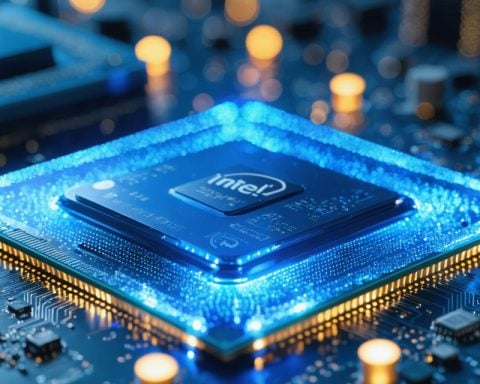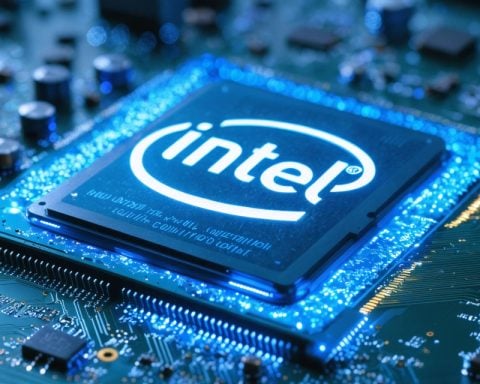- The SEC’s acknowledgment of XRP-linked exchange-traded funds (ETFs) spurs speculation about XRP’s potential recognition as a commodity.
- XRP’s legal status remains ambiguous, with unresolved issues regarding direct sales of XRP as unregistered securities.
- Despite being declared not a security in secondary markets, the SEC’s position creates market uncertainty and volatility for Ripple.
- The SEC’s nod triggered increased trading activity and a price surge for XRP, reaching $2.84.
- XRP’s regulatory journey could influence the future of other cryptocurrencies amid ongoing litigation for major players like Binance and Coinbase.
- Speculation about shifts within the SEC could signal a change in the agency’s approach to Ripple and the broader cryptocurrency landscape.
A flurry of speculation sweeps through the digital landscape, with Ripple’s XRP in the eye of the storm. The catalyst? The U.S. Securities and Exchange Commission (SEC) has taken a step that could shape the future of the cryptocurrency world: acknowledging exchange-traded funds (ETFs) tied to XRP. This move ignites a fiery debate—has the asset finally earned its stripes as a commodity?
Imagine a dense forest, where XRP stands as a lone tree among giants like Bitcoin and Ethereum, yearning for the same recognition. Yet, the SEC’s silent stance clouds this ambition in mystery. With no explicit classification in sight, XRP’s status dangles in uncertainty, a thread swayed by the winds of legal and market forces.
Ripple’s long-standing legal dance with the SEC remains unresolved. A landmark court ruling declared XRP not a security in secondary markets, providing brief respite. Yet, shadows linger over Ripple’s direct sales of XRP, labeled as unregistered securities offerings, perpetuating an air of ambiguity.
The SEC’s nod to XRP-linked ETFs sent ripples through the market. Trading volumes surged, mirroring the vivacity of a bustling bazaar. The price soon leapt skyward, climbing to $2.84, emboldened by the SEC’s apparent softening stance.
The broader narrative is one of potential transformation. XRP’s fate could guide the regulatory compass for other digital assets, particularly as crypto giants like Binance and Coinbase wait in the wings of litigation.
As leadership shifts stir within the SEC, whispers suggest a possible shift in strategy. Should the SEC retract its legal entanglement with Ripple, XRP could ascend beyond its previous peaks. Yet, for now, the crypto world holds its breath, eyes fixed on an uncertain horizon, where the ripple of change could dictate the tides of tomorrow.
Is Ripple’s XRP Ready for a Breakthrough? Unveiling the Potential Game-Changer in Cryptocurrency
How-To Steps & Life Hacks
1. Understanding SEC Developments: Stay informed about rulings and opinions from the SEC regarding cryptocurrencies, as these can significantly impact market dynamics.
2. Investment Strategies: Consider diversification to spread risk while staying updated on XRP news for potential lucrative opportunities.
3. Legal Landscape Navigation: Follow crypto-focused legal experts on social media for insights into ongoing litigation and regulatory changes impacting XRP and other cryptocurrencies.
Real-World Use Cases
– Cross-Border Payments: XRP is used by Ripple’s network to facilitate fast, low-cost international transactions, appealing to financial institutions looking to streamline global payments.
– Liquidity Provider: XRP can be leveraged by exchanges to provide liquidity for trades without maintaining large reserves of fiat currency.
Market Forecasts & Industry Trends
According to a recent report by Financial Analytics, the global cryptocurrency market is expected to reach $5 trillion by 2025, with XRP likely to benefit significantly from any resolution with the SEC, potentially increasing institutional adoption.
Reviews & Comparisons
– XRP vs. Bitcoin & Ethereum: While Bitcoin and Ethereum are often viewed as the gold standard for cryptocurrencies, XRP offers faster transaction speeds and lower costs, making it more suitable for real-time payments.
Controversies & Limitations
– Regulatory Uncertainty: The ongoing legal battle with the SEC remains a significant hurdle, creating volatility in XRP’s value.
– Centralization Concerns: Ripple holds a significant amount of XRP, leading to concerns about centralization, unlike more decentralized assets like Bitcoin.
Features, Specs & Pricing
– Transaction Speed: XRP transactions settle in around 3-5 seconds, much faster than Bitcoin’s 10-minute average.
– Transaction Cost: Approximately $0.00001 per transaction.
Security & Sustainability
– XRP uses a consensus algorithm that is less energy-intensive than Bitcoin’s proof-of-work, aligning with environmental sustainability goals.
Insights & Predictions
Market experts suggest that the resolution of Ripple’s legal issues with the SEC could trigger a bullish run on XRP, potentially doubling its price within months of a positive outcome.
Tutorials & Compatibility
– Integration with Wallets: Popular crypto wallets like Trust Wallet and Ledger Nano S support XRP, ensuring secure storage.
Pros & Cons Overview
Pros:
– Fast and low-cost transactions
– Strong institutional partnerships
– Eco-friendly
Cons:
– Regulatory challenges
– Centralization concerns
Actionable Recommendations
1. Monitor Legal Developments: Investor decisions should be informed by the evolving legal context surrounding XRP.
2. Diverse Portfolio: Incorporate XRP into a broader crypto portfolio to optimize potential returns while mitigating risk.
3. Utilize Industry Tools: Leverage financial news aggregators to keep abreast of changes that might affect XRP’s valuation.
For more insights into the cryptocurrency market, visit Coindesk.


















